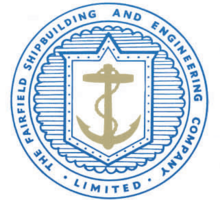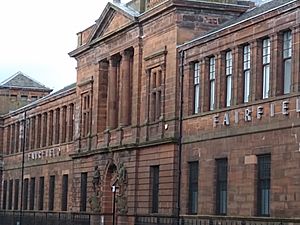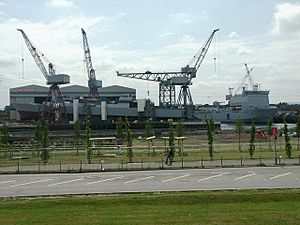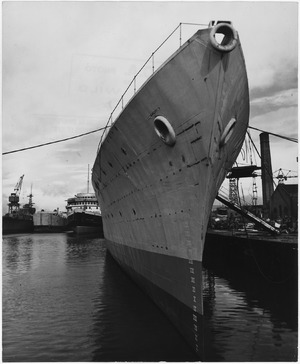Fairfield Shipbuilding and Engineering Company facts for kids
 |
|
| Public company | |
| Industry | Shipbuilding |
| Fate | Merged with others to form Upper Clyde Shipbuilders |
| Predecessor | Randolph, Elliott and Co. Randolph, Elder and Co. John Elder & Co. |
| Successor | Govan Shipbuilders |
| Founded | 1834 |
| Defunct | 1968 |
| Headquarters | Govan, Scotland, UK |
|
Key people
|
Charles Randolph John Elder Sir William Pearce Sir James Lithgow Sir Alexander Kennedy |
| Products | Naval ships Merchant ships Ocean liners Marine engines |
| Parent | Northumberland Shipbuilding Group (1919–1935) Lithgows (1935–1965) |
The Fairfield Shipbuilding and Engineering Company was a famous Scottish shipbuilding company. It was located in the Govan area of Glasgow, right on the River Clyde. People often called it Fairfields.
Fairfields built many important ships. They made warships for the Royal Navy and other countries during both the First and Second World Wars. They also built huge ocean liners that crossed the Atlantic Ocean. Some of these, like the RMS Campania and RMS Lucania, even broke speed records! The company also built smaller, fast ferries for places all over the world, including Istanbul and even some early tourist boats for the River Nile in Egypt.
Contents
How It All Started
Early Days: Randolph & Co.
The company began in 1834 as Randolph & Co. It was founded by Charles Randolph. He had learned a lot about engineering from working at other famous companies.
At first, Randolph & Co. built engines and machinery in Tradeston, a part of Glasgow. They became known for making very accurate gears and large wheels for machines.
In 1839, a Mr. Elliott joined the company, and it became Randolph, Elliott & Co. Sadly, Elliott passed away soon after.
Randolph, Elder and Co. and the New Engines
In 1852, John Elder joined the business, and the company changed its name to Randolph, Elder and Company. John Elder was a very talented engineer. His arrival helped the company start building ship engines.
The company became world-famous for its special "compound steam engines." These engines were a big deal because they used steam more efficiently. This meant ships could travel further using less coal, which saved a lot of money!
One of their first successful compound engines was in the screw steamer Brandon in 1854. It used much less coal than other ships of its time. Even though it was better, other companies didn't use this new engine right away. For many years, Randolph, Elder and Co. were the only ones making them.
The Pacific Steam Navigation Company became a huge fan of these new engines. They operated ships on the west coast of South America, where fuel was expensive. When a war made coal even pricier, they needed a solution.
Randolph, Elder and Co. built new "double-cylinder engines" for their ships like Inca and Valparaiso. These engines were even more efficient, saving 30-40% on fuel! This allowed the company to keep using steamships profitably. In fact, some of their older ships even had their old engines removed and replaced with these new, fuel-saving ones.
Between 1854 and 1866, Randolph, Elder & Co. built many compound engines for both paddle steamers and screw ships. They even converted a warship, HMS Constance, to steam power.
Starting to Build Ships
In 1858, the company bought the Govan Old Shipyard and started building entire ships, not just engines. Their first ship, Macgregor Laird, was built in 1861.
The business grew quickly, and in 1864, they moved to a new, bigger shipyard at a place called Fairfield Farm in Govan. Between 1861 and 1866, they built 59 ships!
A big change happened in 1868 when Charles Randolph retired. John Elder became the sole owner of the company.
John Elder & Co. Grows Even More
After John Elder passed away in 1869, his wife ran the business for a short time and renamed it John Elder & Co. in his honor. She then sold it to new partners, including William Pearce. William Pearce eventually became the sole owner in 1878.
The new owners kept expanding the shipyard. They built many ships for important customers, including the Pacific Steam Navigation Company and the Stoomvaart Maatschappij Nederland.
The company built some of the largest and fastest ships of its time. For example, in 1870, they launched Italy, which was one of the biggest ships afloat. They also built speedy steamers like City of London and Ban Righ, which were much faster and used less fuel than older ships.
Fairfield Shipbuilding and Engineering Company Today

In 1886, William Pearce turned the company into a limited company and officially changed its name to the Fairfield Shipbuilding & Engineering Co., named after the old farm. The land where the farm used to be was bought by John Elder's wife, Isabella, and given to the people of Govan to become Elder Park.
The shipyard's main offices, known as the Drawing Offices, are very grand buildings made of red sandstone. They were designed by famous architects between 1889 and 1891.
In February 1897, a large fire broke out at the shipyard. Many buildings were destroyed, but luckily, the ships being built, like HMS Argonaut and RMS Empress Queen, were saved.
Fairfield was known for its skilled managers and engineers. Sir Alexander Gracie, who became chairman in 1909, was considered one of Britain's greatest naval architects. Even the first woman in the UK to qualify in naval architecture, Dorothy Rowntree, worked for the company in the 1920s.
The yard also had the Fairfield Titan, a giant crane built in 1911. For many years, it was the largest crane in the world, able to lift huge engines and boilers into ships. It was taken down in 2007 during modernization work.
Changes in Ownership
In 1919, Fairfield became part of the Northumberland Shipbuilding Company. Later, in 1935, it was taken over by Lithgows, another shipbuilding company.
In the 1950s, the shipyard went through a big modernization project that cost £4 million. This helped make the yard more modern and efficient.
However, in 1965, Fairfield Shipbuilding and Engineering Ltd. faced financial trouble and was sold by Lithgows.
The Fairfield Experiment
In 1966, the shipbuilding part of the company was restarted as Fairfield (Glasgow) Ltd. This period became famous as the "Fairfield Experiment." It was an attempt to try new ways of working to improve how much the shipyard could produce. They tried new ideas for how workers and management could work together. This time was even shown in a documentary film called The Bowler and the Bunnet.
Later Years and Nationalization
In 1968, Fairfield became part of a larger group called Upper Clyde Shipbuilders. This group faced difficulties and eventually collapsed in 1971.
As part of a plan to save the shipyards, Fairfields became Govan Shipbuilders in 1972. Later, in 1977, it was taken over by the government and became part of British Shipbuilders.
The Shipyard Today
When British Shipbuilders was broken up in 1988, the old Fairfield yard was sold to a Norwegian company called Kværner and renamed Kvaerner Govan.
In 1999, the yard was bought by BAE Systems Marine and is now part of BAE Systems Surface Ships. This means the historic shipyard is still building ships today!
Famous Ships Built at Fairfield
Fairfield built many well-known ships, including:
- Famous Liners:
- RMS Campania
- RMS Lucania
- RMS Empress of Britain (1905)
- RMS Empress of Ireland
- RMS Empress Queen
- SS Assiniboia
- SS Keewatin
- SS Volturno
- TEV Wahine
- Warships for the Royal Navy:
- Battlecruisers like HMS Indomitable and HMS Renown
- Battleships like HMS Valiant and HMS Howe
- Cruisers like HMS Liverpool
- Destroyers like HMS Maori (F24) (HMS Maori)
- Submarines like HMS K13 and HMS L55
- Aircraft carriers like HMS Implacable and HMS Theseus
- Other Notable Ships:
- HMS Cressy (1899) (HMS Cressy) and HMS Aboukir (1900) (HMS Aboukir) (sadly, these were among the first ships ever sunk by a German U-boat in 1914)
- Passenger steam ships for Turkish Maritime Lines, like S/S Tarzi Nevin and S/S Halas.
- Clyde paddle steamers like PS Jeanie Deans and PS Jupiter.
- The icebreaker CGS Stanley.
See also
- Ocean liners for Canadian Pacific Steamships:
- RMS Empress of Britain
- RMS Empress of Ireland
- RMS Empress of Asia
- RMS Empress of Russia
- RMS Empress of Canada
- RMS Empress of Japan
- John Elder F.C. (a football team from the shipyard that played in the Scottish Cup)



